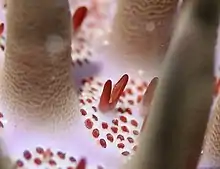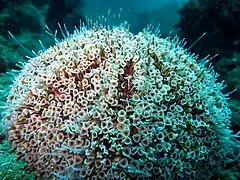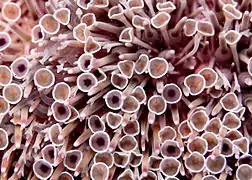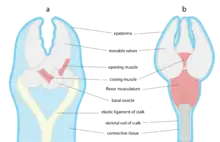Pedicellaria
A pedicellaria (plural: pedicellariae) is a small wrench- or claw-shaped appendage with movable jaws, called valves, commonly found on echinoderms (phylum Echinodermata), particularly in sea stars (class Asteroidea) and sea urchins (class Echinoidea). Each pedicellaria is an effector organ with its own set of muscles, neuropils, and sensory receptors and is therefore capable of reflex responses to the environment. Pedicellariae are poorly understood but in some taxa, they are thought to keep the body surface clear of algae, encrusting organisms, and other debris in conjunction with the ciliated epidermis present in all echinoderms.

In sea stars

Types
There are two major types of pedicellaria in sea stars: straight and crossed. Straight pedicellaria are typically larger and located on the body surface, whereas crossed pedicellaria are smaller and found more commonly on stalks, raised above the body surface or in clumps circling the spines. The crossed type is connected to the test by an elastic ligament.
Location
Sea star pedicellariae may be located on the test's surface or mounted on flexible stalks. Depending on the species, pedicellariae may be surrounding the spines, on the surface of the animal's body, in pits on the abactinal, marginal, or actinal surface, and/or within the adambulacral plate adjacent to the tube foot furrow.[1] Forcipulate sea star are so called because each pedicellaria is typically composed of three forceps-like valves. Other asteroids can have pedicellariae composed of only two components.
Function
Pedicellariae in some taxa, such as the deep-sea Brisingida, and the Antarctic Labidiaster are known to function in food capture.
In sea urchins

Types
Four main forms of pedicellariae are found in sea urchins : tridactylous, ophicephalous, triphyllous and globiferous. There are typically three valves that make up the jaw of sea urchin pedicellaria. The stalk is composed of a skeletal rod and a flexible neck portion.
Location
They are generally attached by a long, inflexible stalk and may be found anywhere on the sea urchin's test.
Function
In some families, globigerous pedicellariae have evolved into venomous structures, used for protection or maybe hunting. This is particularly the case in the family Toxopneustidae, some species such as Tripneustes gratilla and especially Toxopneustes pileolus being extremely venomous.[2]
 The dangerous flower urchin in Taiwan, with its long flower-like venomous pedicellariae
The dangerous flower urchin in Taiwan, with its long flower-like venomous pedicellariae Close-up of flower urchin pedicellariae
Close-up of flower urchin pedicellariae Tripneustes gratilla is also covered with venomous pedicellariae, but is less dangerous.
Tripneustes gratilla is also covered with venomous pedicellariae, but is less dangerous.
References
- Ruppert, Edward E.; Fox, Richard, S.; Barnes, Robert D. (2004). Invertebrate Zoology, 7th edition. Cengage Learning. pp. 877–878. ISBN 978-81-315-0104-7.
{{cite book}}: CS1 maint: multiple names: authors list (link) - Christopher Mah (2014-02-04). "What we know about the world's most venomous sea urchin Toxopneustes fits in this blog post !". Echinoblog..
